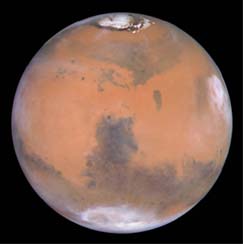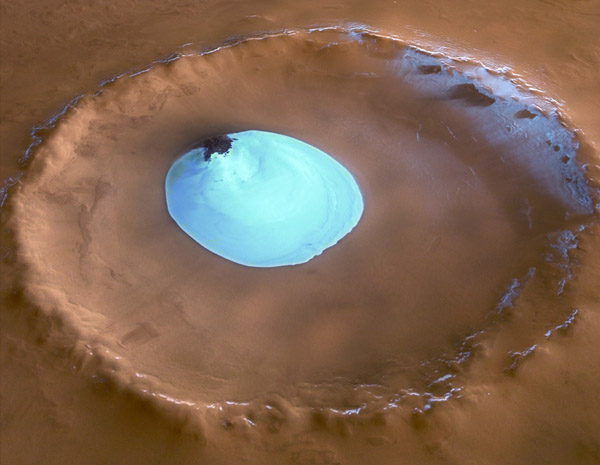Evidence for Present Water on Mars
 | The present atmospheric pressure on Mars, about 5 mmHg, is too low for water to exist in liquid form. There is a large amount of water ice in the north polar cap. We can get a reasonable estimate of the amount of water there because the summer temperature warms up enough to evaporate off the dry ice seasonal cap, leaving only water ice. That 1000 km permanent cap with depth approximately 3 km contains some 1018kg of water, an amount which Fraknoi, et al. liken to the amount of water in the Mediterranean Sea. |
The south polar cap always has frozen carbon dioxide on it, so we can't get a clear estimate of the amount of water ice there. There is some water in the atmosphere, as evidenced by the water ice clouds which form around mountains like Olympus Mons.
In 2002 additional data was collected by the Mars Odyssey mission which attempted to find evidence for sub-surface water on Mars. The instruments were the Gamma-Ray Spectrometer, the Neutron Spectrometer, and the High Energy Neutron Detector. Those instruments mapped the flux of gamma rays and secondary neutrons, which can serve as evidence for hydrogen in the top meter of the martian surface. The data support a water ice-rich layer about 30-60 cm deep in the region above 60° latitude, near both poles. The surface material of Mars, called regolith, in these regions may be 20 to 35% by weight of water ice. The amount of evidence for water diminishes near the equator where the regolith layer extends to about a meter in depth.

Photo credit: ESA/DLA/FU Berlin (G. Neukum)
The above photo from the European Space Agency's Mars Express mission was taken on Feb 2, 2005. It shows a sheet of residual water ice in the crater. The crater is in the far northern latitudes of Mars. Reference: http://www.esa.int/SPECIALS/Mars_Express/SEMGKA808BE_1.html
Mars Concepts
Solar System Illustration
Solar System Concepts
References
Fraknoi, Morrison, Wolff
Ch 9
Boynton, W. V. et al.
| HyperPhysics********** Astrophysics | R Nave |